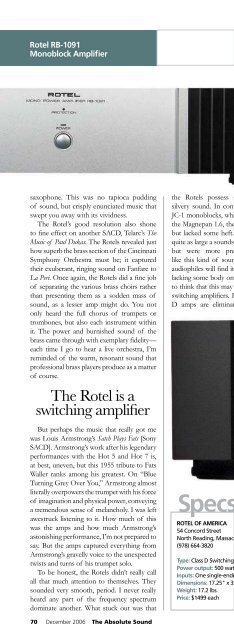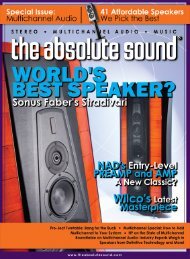Create successful ePaper yourself
Turn your PDF publications into a flip-book with our unique Google optimized e-Paper software.
Rotel RB-1091<br />
Monoblock Amplifier<br />
saxophone. This was no tapioca pudding<br />
of sound, but crisply enunciated music that<br />
swept you away with its vividness.<br />
The Rotel’s good resolution also shone<br />
to fine effect on another SACD, Telarc’s The<br />
Music of Paul Dukas. The Rotels revealed just<br />
how superb the brass section of the Cincinnati<br />
Symphony Orchestra must be; it captured<br />
their exuberant, ringing sound on Fanfare to<br />
La Peri. Once again, the Rotels did a fine job<br />
of separating the various brass choirs rather<br />
than presenting them as a sodden mass of<br />
sound, as a lesser amp might do. You not<br />
only heard the full chorus of trumpets or<br />
trombones, but also each instrument within<br />
it. The power and burnished sound of the<br />
brass came through with exemplary fidelity—<br />
each time I go to hear a live orchestra, I’m<br />
reminded of the warm, resonant sound that<br />
professional brass players produce as a matter<br />
of course.<br />
the Rotels possess a transparent, almost<br />
silvery sound. In contrast to the Parasound<br />
JC-1 monoblocks, which were also powering<br />
the Magnepan 1.6, the Rotels sounded faster<br />
but lacked some heft. They also didn’t have<br />
quite as large a soundstage as the Parasounds,<br />
but were more precise. Tradeoffs: You<br />
like this kind of sound or you don’t. Some<br />
audiophiles will find it too clean and perhaps<br />
lacking some body on the notes. I’m starting<br />
to think that this may be an inherent part of<br />
switching amplifiers. Is it possible that Class<br />
D amps are eliminating a coloration that<br />
more conventional amplifiers share Will<br />
Class D amplifiers, in turn, push designers<br />
to eliminate colorations that hadn’t seemed<br />
intrusive until now<br />
I don’t know the answer to those questions.<br />
But it’s a little unnerving to think that Rotel is<br />
offering performance that would have cost a<br />
bundle a decade ago, and that, in some ways,<br />
might not even have been achievable. To be<br />
sure, as I suggested at the outset, the Rotels<br />
will not match up to megabuck systems, and<br />
aren’t really intended to. Money makes a<br />
difference. The more you spend intelligently,<br />
the better your system will sound. But how<br />
far do you really want to go in chasing<br />
audiophile rainbows Throwing dollars at<br />
your system can sometimes produce as much<br />
frustration as satisfaction. The Rotels are<br />
neutral and nimble amplifiers that will power<br />
most loudspeakers, providing sound that is<br />
very hard to reproach. If you’re looking for<br />
an amp that provides more than an entry into<br />
the high-end for a reasonable price, the Rotels<br />
are well worth considering. TAS<br />
Rote<br />
Mon<br />
The Rotel is a<br />
switching amplifier<br />
But perhaps the music that really got me<br />
was Louis Armstrong’s Satch Plays Fats [Sony<br />
SACD]. Armstrong’s work after his legendary<br />
performances with the Hot 5 and Hot 7 is,<br />
at best, uneven, but this 1955 tribute to Fats<br />
Waller ranks among his greatest. On “Blue<br />
Turning Grey Over You,” Armstrong almost<br />
literally overpowers the trumpet with his force<br />
of imagination and physical power, conveying<br />
a tremendous sense of melancholy. I was left<br />
awestruck listening to it. How much of this<br />
was the amps and how much Armstrong’s<br />
astonishing performance, I’m not prepared to<br />
say. But the amps captured everything from<br />
Armstrong’s gravelly voice to the unexpected<br />
twists and turns of his trumpet solo.<br />
To be honest, the Rotels didn’t really call<br />
all that much attention to themselves. They<br />
sounded very smooth, period. I never really<br />
heard any part of the frequency spectrum<br />
dominate another. What stuck out was that<br />
<strong>Specs</strong> & <strong>Pricing</strong><br />
ROTEL OF AMERICA<br />
54 Concord Street<br />
North Reading, Massachusetts 01864<br />
(978) 664-3820<br />
Type: Class D Switching Amplifier<br />
Power output: 500 watts into 8 ohms<br />
Inputs: One single-ended (RCA)<br />
Dimensions: 17.25" x 3.75" x 16.25"<br />
Weight: 17.2 lbs.<br />
Price: $1499 each<br />
ASSOCIATED EQUIPMENT<br />
VPI-HRX turntable and JMW 12.6 tonearm;<br />
Sony SCD-777ES SACD/CD player; EMM Labs<br />
DCC2 preamplifier/DAC and EMM Labs CDSD;<br />
Messenger and Convergent Audio Technology<br />
Mk. 3 preamplifiers; Parasound JC-1 and VTL 750<br />
monoblock amplifiers; Magnepan 20.1 and 1.6<br />
loudspeakers; Jena Labs and Cardas Golden Cross<br />
cables; Shunyata Hydra-6 and PS Audio P-300<br />
power regenerator<br />
70 December 2006 The Absolute Sound










